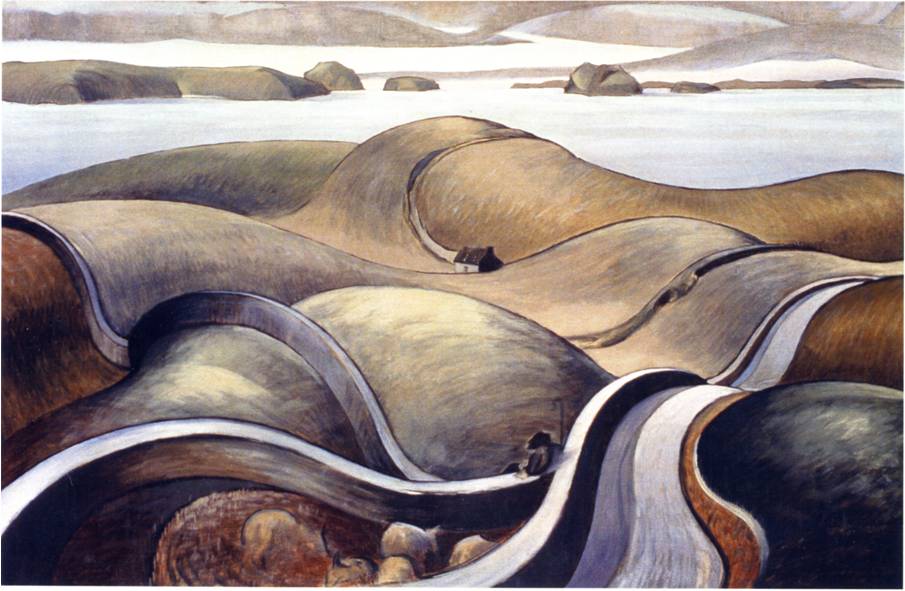
THE RALPH MAYNARD SMITH TRUST___ ( Registered Charity Number : 1049843 ) |
| Home | Gallery | Biography | Archive of Drawings and Paintings | RMS Trust and Database |
| Exhibition & Projects | Ancillary Archive - Writings | Ancillary Archive - Architecture | Work in Progress |
Click images to enlarge |
Updated July 2017 |
 |
| 1. "Shepherd Landscape". 1929 - 1945. Oil on canvas. 24 x 36 inches. K170.00. Private Collection. |
| Gallery An Account of the Artist’s Development |
Largeness of concept, precision of form and depth of space are characteristic qualities of almost everything RMS produced, including many small and apparently casual sketches. These drawings are his answer to an apparently endless flow of ideas, only a small portion of which he was able to develop, but which show him to have been a prolific artist. Although he was successful in producing larger oil paintings like "Shepherd Landscape" and "Circles and Moon", the limitations imposed by his lifestyle meant that such achievements became increasingly rare as time went on. |
| Commentary |
|
| “Mountain ranges in sharp profile, hills rippling and rearing, stiffened clumps of trees, stealthy streams and contorted plant-life, massed boulders, forked paths, abrupt cliffs and crags, moonstruck beaches and alluring clouds—the spaces imaged in Ralph Maynard Smith’s art are the outcome of a dynamic process whereby reminiscences of actual observations are enhanced and often superseded by the most uninhibited reveries and visionary inventions.” |
1920s Mull and Iona to early 1940s Surrey |
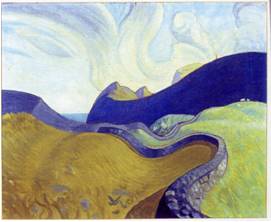 |
|
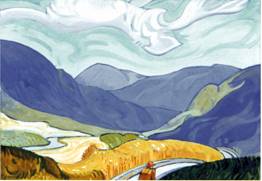 |
||
| 2. “Walls”. 1928. Oil on canvas. 17 x 21 inches. K.172.00. RMS Trust Collection | 3. “Andante”. 1927. Oil on canvas board. 9.75 x 11.375. K.166.00. Private Collection | 4. ‘Self-Portrait in the Hills’. 1927. Oil on canvas. 16 x 22.75 inches. K.164.00. RMS Trust Collection |
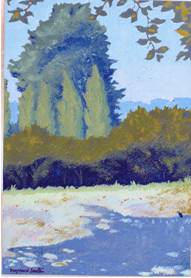 |
___ | 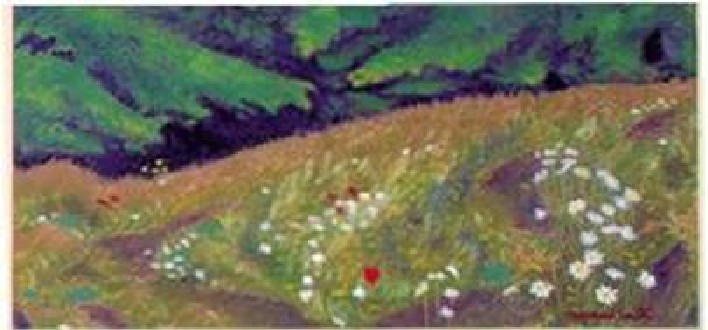
|
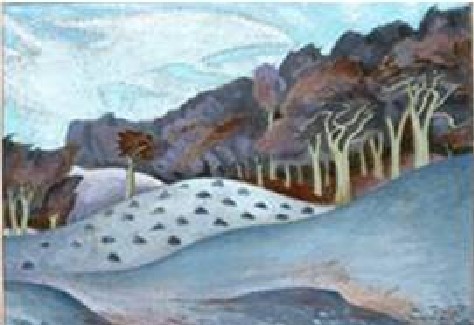 |
|
| 5. “June Greens”. 1941. Oil on paper. 7.5 x 5.125 inches. K.542.00. RMS Trust Collection | _6. “Edge of the Wood, June”. 1943. Oil on paper. ___3.75 x 7.5 inches. K.683.00. Private Collection | 7.“Edge of the Wood, Winter”. 1942. Oil on paper. 5.125 x 7.5 inches. K.614.00. Private Collection |
“The poet Charles Baudelaire once wrote in his notebook that ‘in certain spiritual states which are all but supernatural, the profundity of life is exposed in its entirety through the spectacle that one happens to find before one’s eyes, however ordinary it may be. It becomes a Symbol thereof.’ What Maynard Smith learned to do in his picturemaking was to absorb the shapes he had encountered while afoot in the actual landscape and let them flow out again as the constituents of a symbolic topography, a private realm of phantasmal forms in which inhere connotations and metaphors, often secret and abstruse. He thereby became a perfect alchemist of the visual, an adept who co-ordinates perceptions of the external world with an archetypal imagery generated from within by what Gaston Bachelard termed ‘’the material imagination.’
|
Late 1930s to late 1940s |
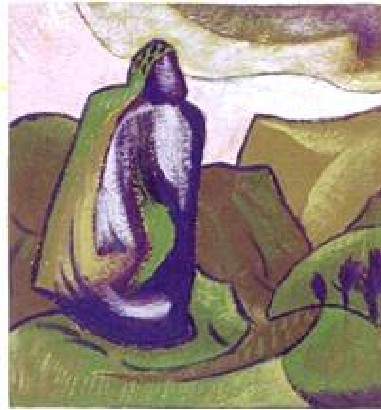 |
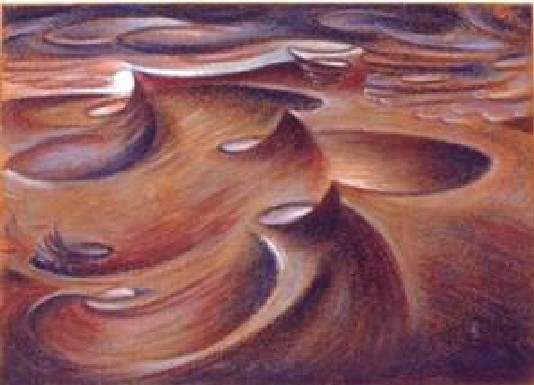 |
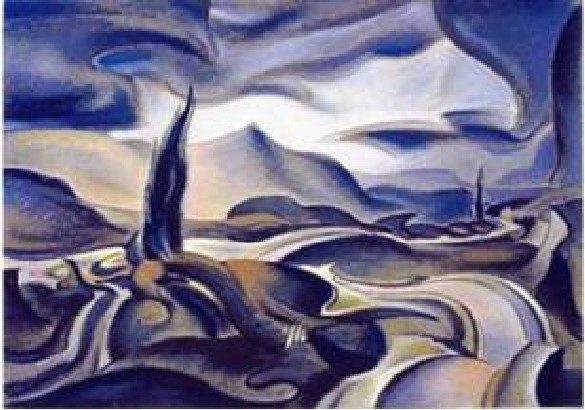 |
||
| 8. “Figure in the Hills”. 1938. Oil on paper. 5 x 4.75 inches. K.464.00. RMS Trust Collection
|
9. “Place of Departure”. 1946. Pastel & charcoal. 8.625.00 x 12.25 inches. Collection National Galleries of Wales, Cardiff | 10. “Free Is the Prospect Here”. 1946. Watercolour & pastel. 8.75 x 12.375 inches. Collection National Galleries of Wales, Cardiff |
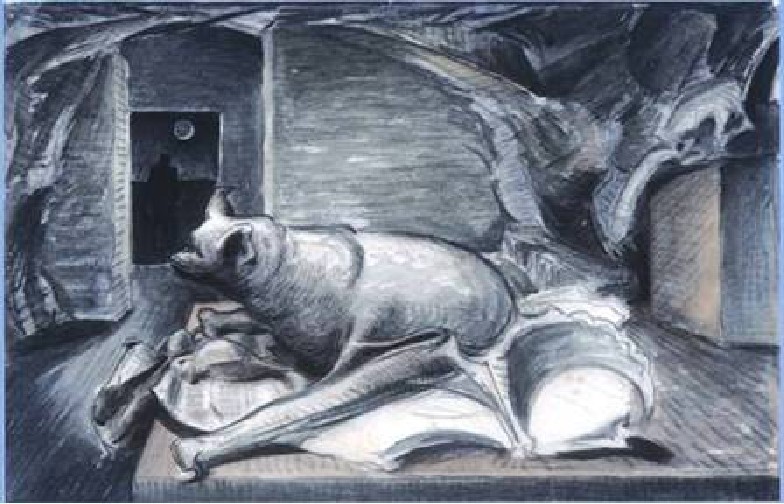 |
|
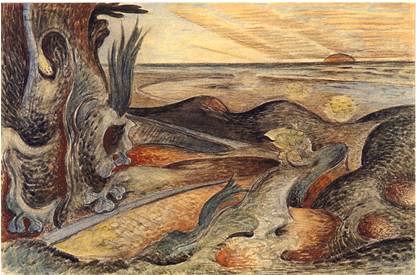
|
| 11. "Interior with Bat". 1947. Watercolour with charcoal. 14 x 21.25 inches. K933.00. RMS Trust Collection | 12. "Better Be Yourself, Better Make Your Own Music". 1948. Watercolour with charcoal. 14.5 x 21.75 inches. K1010.00. Collection British Museum. |
Transitions leading to “Free Is the Prospect Here” |
|
| Commentary |
|
“Blake features in one of the opening comments in ‘The Ravine’: ‘To Blake there was no real world but that apprehended by vision’, followed by Maynard Smith’s own observation: ‘The artist is the man who leaves the crowd and goes pioneering. With him there is an idea which is his life.’ The implicit notion of pilgrimage should be understood too in relation to Ruskin’s characterisation of ‘imagination penetrative’ in Volume II of ‘Modern Painters’: … many painters of powerful mind have been lost to the world by suffering the restless writhing of their imagination in its cage to take place of its healthy and exulting activity in the fields of nature … Fancy plays like a squirrel in its circular prison, and is happy; but imagination is a pilgrim on the earth — and her home is in heaven.’ Another recurrent theme is Maynard Smith’s musical interpretation of nature attested to by many of his titles; these serve to define the mood of particular compositions and to help structure his work as a whole, in which each part plays its role as an orchestral movement.” |
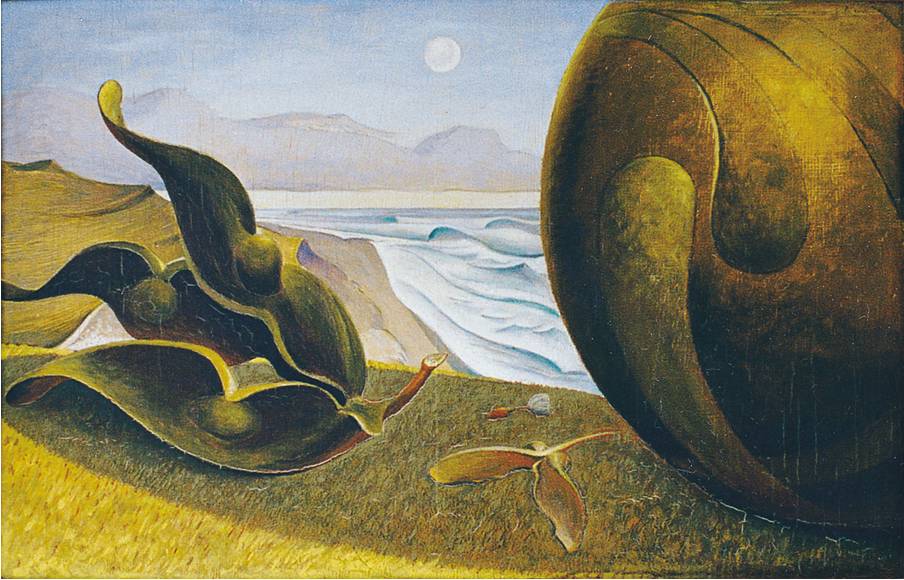 |
| 13. “Eclipse of the Winged Embryo”. 1949. Oil on ply panel. 13 x 20.5 inches. Collection: University of Hertfordshire |
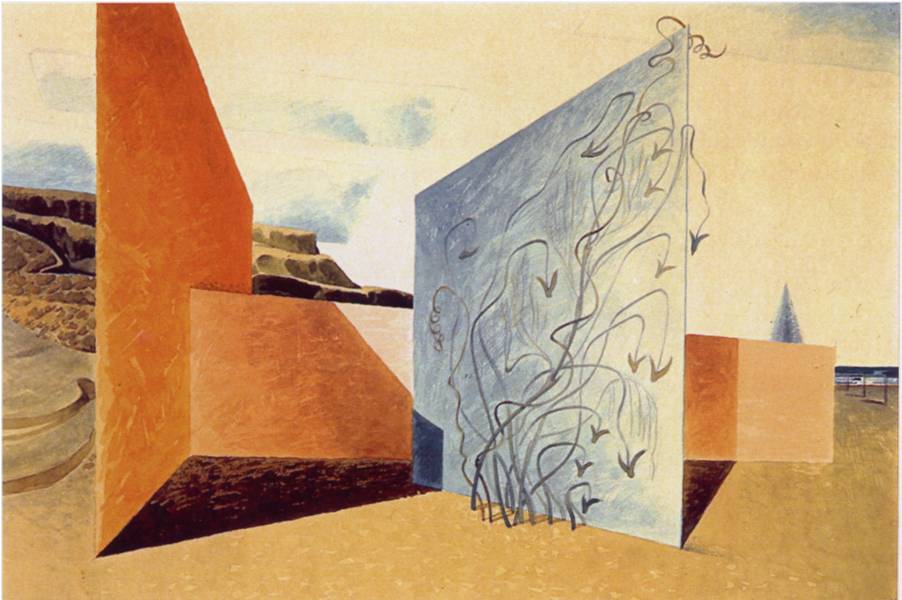 |
| 14. “Vertical Surfaces on a Beach”. 1951. Watercolour. 15 x 22 inches. K.1296.00. Private Collection. |
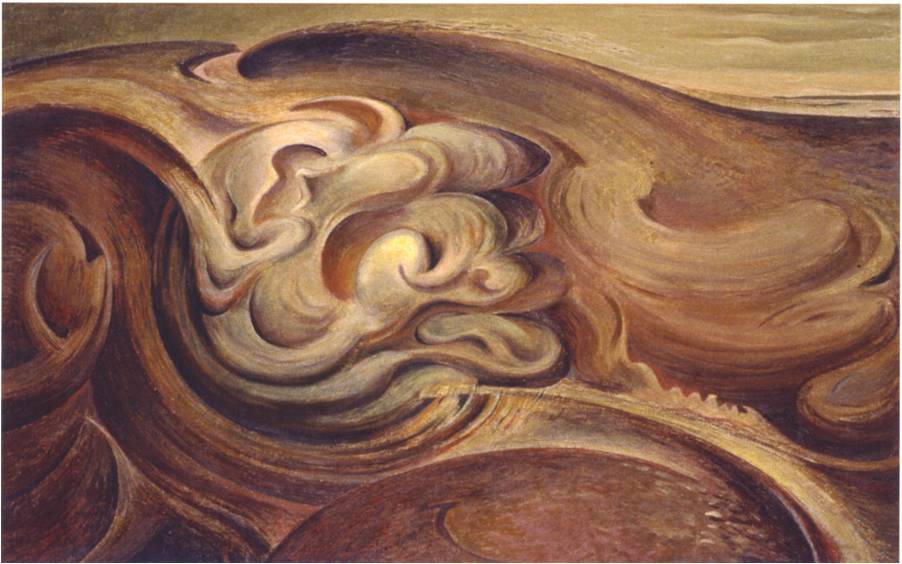
|
| 15. “Wordless Urges”. 1952. Oil on ply panel. 16.75 x 26 inches. RMS Trust Collection |
| From the 1950s on — “Districts of My Kingdom” |
|
“Ralph Maynard Smith was sufficiently aware of many of these antecedents to have assimilated [i.e. by the late 1930s. Ed] the basics of the art of symbolic landscape, recognising with Ruskin that the creative imagination needs to be 'dream-gifted' and concurring with André Breton's dictum whereby 'the imaginary is that which tends to become real'. Maynard Smith was no stranger to the idea of the artistic temperament projecting its inventions onto the external world.” |
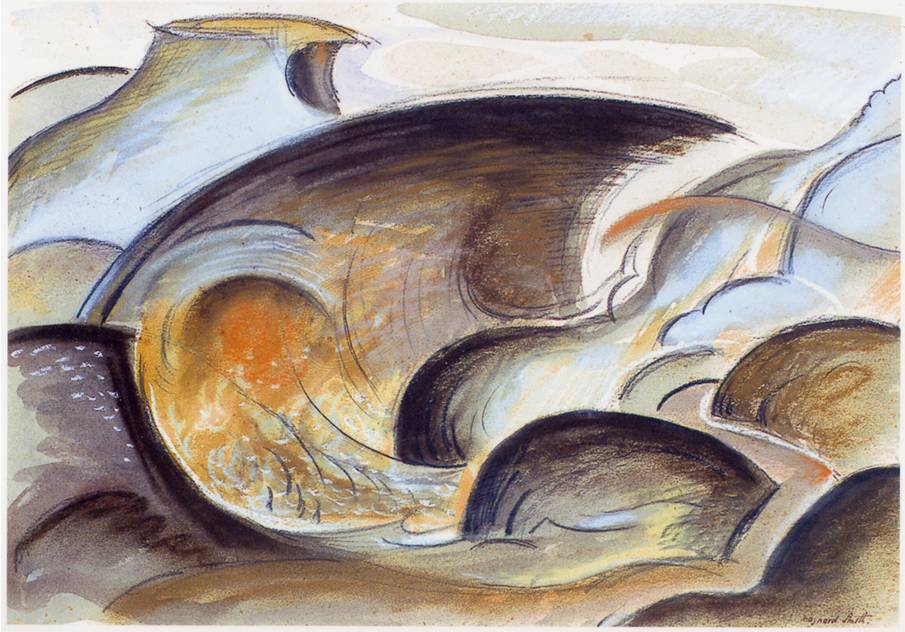 |
| 16. “Pebble Hollow”. 1947. Watercolour and pastel. 8 x 11.5 inches. K.944.00. Private Collection |
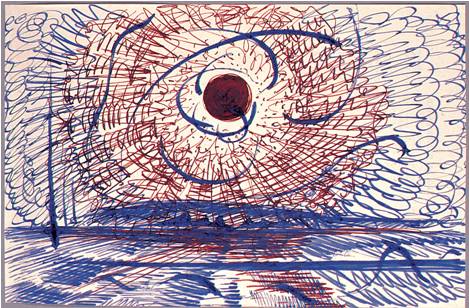 |
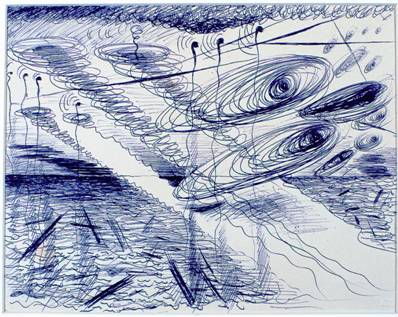
|
|
| 17. ‘Memories Field Blown Bare, Hurricane’. 1953. Pen with blue & brown inks. 5.125 x 8 inches. K.1368.00. RMS Trust Collection. |
|
18. ’Great Storm over the Sea’. 1961. Pen and ink. 7 x 9 inches. K.1656.00. RMS Trust Collection |
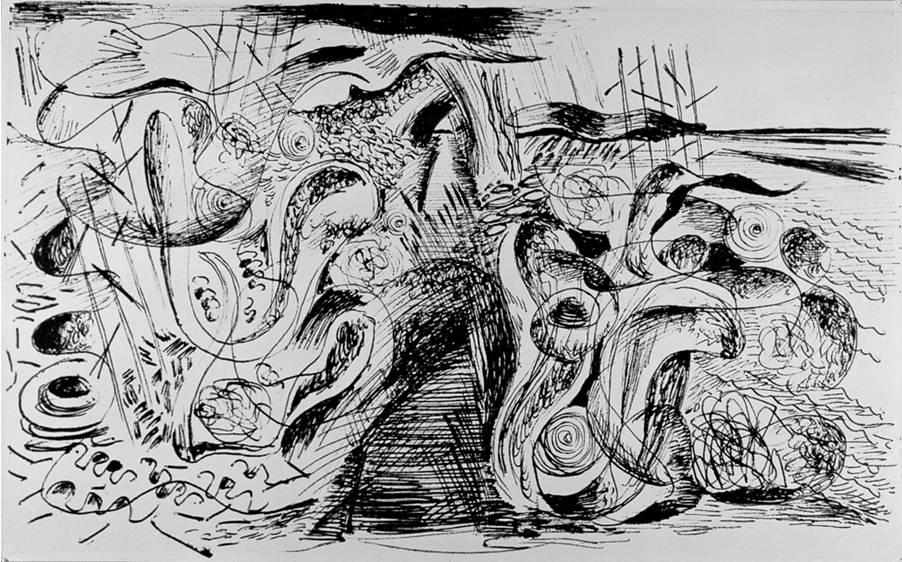 |
| 19. ‘Canal by the Shoreline’. 1956. Pen & ink. 5.375” x 8.875”. K1443.00. Private Collection This is the 1963- 4. ‘Photomural’ version from the original drawing, as approved by the artist. 21 x 35 inches. RMS Trust Collection. |
Late 1950s to early 1960s — “Memories Fields” |
|
“...after the sunlit early landscapes - sturdily constructed from long curves, airy and optimistic - and the gracefully monumental, surrealistic paintings of 1947-50, he eventually entered a more disturbed and disturbing place, more sea and sky than land, more memory than observation, more internal than external.”
|
|
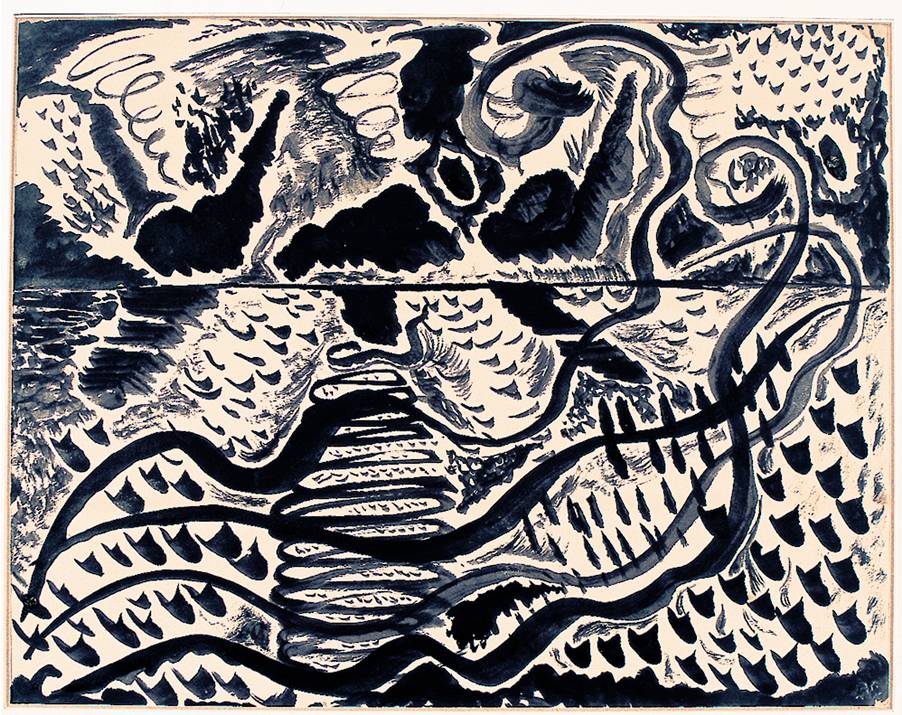
|
| 20. ‘Storm Destroying Memories Field’. 1961. Indian ink brush drawing. 7 x 9 inches. K.1645.00. RMS Trust Collection |
| Return to top | All material copyright © RMS Trust 2012 | |